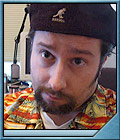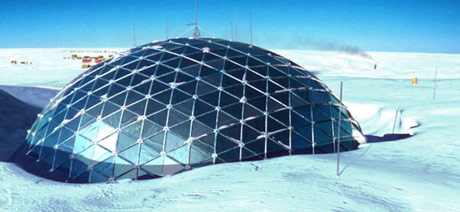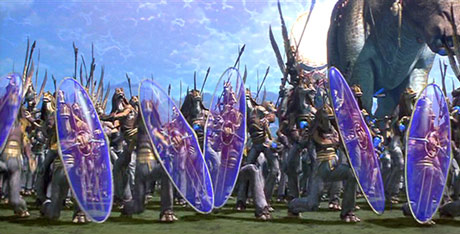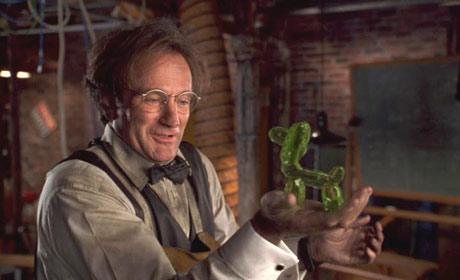Date
of publishing: 21st September 2005
 Philip Edward Alexy is a Character/Creature/Effects CGI Animator
and worked on several TV shows and movies such as Star Wars
Episode 1, Deep Impact, Flubber, Jumanji, Casper, Jack Frost,
101 Dalmatians, ... and he made the Antarctica Dome for the
Stargate SG-1 episode "Frozen" (season 6). You can
have more informations and details on his work and resume
on his website: http://www.flyingsheep.org
Philip Edward Alexy is a Character/Creature/Effects CGI Animator
and worked on several TV shows and movies such as Star Wars
Episode 1, Deep Impact, Flubber, Jumanji, Casper, Jack Frost,
101 Dalmatians, ... and he made the Antarctica Dome for the
Stargate SG-1 episode "Frozen" (season 6). You can
have more informations and details on his work and resume
on his website: http://www.flyingsheep.org
Gilles Nuytens: First
thank you for taking a few of your time to answer these questions.
Can you describe the work you are doing, the different parts
of it ?
Philip: Well, right now I am part of a team
that is developing a children's TV series for the international
market called Plimmy and Pykko. Here is the website: http://www.styles-and-stories.com/projects-plimmy.htm
What I really like about this project is not just that I am
the animation supervisor (ahh, the power...the POWER! Mwhahahahaha...ahem!),
but I also have a hand in the screenplays, look, character
design, and marketing.
Gilles Nuytens: More
specifically, can you describe the different steps of digital
effects from the beginning of the project to the final product,
when the episode/movie is ready for screening?
Philip: In digital effects, things
always start with a bull-session with the clients to see
exactly what they are looking for in that series/episode/movie.
Usually, they have some concept drawings or rough storyboards
with them so we can decide what we can or can't do in the
time provided and the budget they have. Second is refining
the 'boards and designs until we have something we all can
agree on, sometimes we take the concept drawing and do some
fooling about in Photoshop or make some basic CG models.
On a TV series, we pretty well go from there to where they
are shooting on set. Hopefully, and this isn't always the
case, we have a CG supervisor there at the shooting to advise
them. When we get the shot film, or plates, we start integrating
the effects, be it an explosion, set extension, or character/creature
animation. After a few screenings with the client, we do
the final composite with colour correction and other fun
CG-to-video stuff, and they cut it into the show. Now on
a film project, there is usually a bigger budget so we spend
more time in the planning stage, usually because we need
to render out in a higher resolution and, to be frank, a
little higher quality. So usually the storyboarding phase
is longer and we usually do 3d animatics to help set up
camera angles and the like.

Gilles Nuytens: You
have used a lot of 3D softwares, which one is for you the
best or at least your favorite one and why ? Which software
could you recommend for beginners?
Philip: Well, and this is hoping
Alias will have a nice check for me in the mail soon, I
have to say that Maya is my favourite so far for overall
use in a CG production. Now this isn't saying that the others
don't have their strengths (and weakness) as well. I found
that Houdini has the best realistic particle package I have
ever seen, while its interface is the hardest to master.
Its approach to CG is unlike any other package out there
and it takes a while to get into their mindset. Lightwave
is a good, overall package to TV and productions on a tight
budget, but their basic animation tools are somewhat lacking.
XSI is also a very good package and I love the way MentalRay
is integrated, but it doesn't have some of the strengths
of interface and intuitive module use that Maya has. And
3DStudioMax...well, it does have it's strength for use in
Games and non-linear animation, but not my choice package
for CGI effects.
Gilles Nuytens: What
is the part you prefer in your job? 3D modeling, animation,
texturing, lightning, post work with Photoshop? And why?
Philip: I prefer animation. It is what
I trained in and what I love. I do a little dabbling in
modeling and editing, but I always go back to animation.
Gilles Nuytens: You
made this Antarctica dome for the episode of Stargate that
we can see in season 6, is it also your work that we see
in the pilot of Atlantis?
Philip: Gosh...I have to say I haven't
seen any of the new series so I couldn't say.
More information about the dome:"The team
had a two week deadline to do a test: take a still of the
Amundsen-Scott South Pole Station and recreate it in full
3D without using the cheat of projection mapping. I am happy
to say that my team performed amazingly and when the effects
supervisor from Stargate saw the finished product, he was
very impressed!" (from: http://www.flyingsheep.org/work/tv/html/tv_stg.html)
Gilles Nuytens: Will
you work again for Stargate or have you been contacted to
work on other popular shows such as Galactica?
Philip: If offered, I would be interested
to work on either of these shows if there was some good
character stuff to work on.
Gilles Nuytens: Does
the CGI artists meet sometimes the cast of the shows or
movies from the movies you are working on? Anything to tell
about that?
Philip: Sometimes. I have met most of the
directors of shows I have worked on (like George Lucas,
Mimi Leder and Chuck Russel) but really don't meet many
of the stars. I have met Cathy Moriarty who played Carrigan
in “Casper” and the three voice actors for the
ghosts, Joe Nipote, Joe Alaskey, and Brad Garrett (who plays
Ray's older brother on “Everybody Loves Raymond”).
I also had the chance to meet Sean Connery once. I saw him
just for a minute or so. I ALMOST got to meet Robin Williams
twice, but, in fact, never did. But the one person that
I did meet, that wasn't on the cast of the movies I have
worked on, but meant the most for me personally, was Chuck
Jones . He came to ILM twice to talk about his life and
his work and the second time, I was actually able to shake
the man's hand. When he passed away, it was a very sad day.

Gilles Nuytens: What
is for you the most difficult part of your job ? And what
would be your biggest challenge ? Could you explain?
Philip: The most difficult part of my job
is knowing when to stop working on a shot. I always want
to make a little bit better The biggest challenge is working
in a team environment...everyone has their own ideas and
strenghts and weaknesses. Being a supervisor means knowing
how lead and direct these great creative forces to what
the client wants. And this is still something I have lots
to learn and work very hard at.
Gilles Nuytens: Your
are specialized in 3D animation, can you describe the different
steps of animating a scene, once you have all the information,
storyboards, etc. from the client ?
Philip: Well, first thing is to see if
there needs to be any matchmoving to do...usually you have
to do a little even for a non-moving camera shots, just
to get some
sense of the space the shot takes place. Usually you get
this information from the VFX sup on set, stuff like measurements
or, at least, lens information. But there have been times
where I have had NO info from the shoot and just had to
guess. Next is to see if my character/creature has any interact
with objects in the plate...if so, that's another thing
I should get matchmoved. Then it is animation time! Usually
I go thru blocking out the scene using the lo-res version
of the model and then do a rough composite and show it to
the client, to see if the shot is going in the direction
they want. If I get the okay, I finesse the animation, showing
it at least two more times to the client. There have been
many a time when at these two later steps I get asked to
redo the entire scene...it is frustrating, to be sure, but
they pay the bills. When we finally get to the point that
everyone is happy with my animation, I had it off to the
technical director and they do all their lighting and texturing
goodness. SOmetimes I get called back to tweak a little,
but that's about it for me, the animator.
Gilles Nuytens: What
modeling technics do you prefer ? Box modeling or poly by
poly ? And what is easier to learn?
Philip: I think polygonal modeling is the
easiest but I am not sure what you mean by box or poly-by-poly.
Gilles Nuytens: For
you what is easier, to work with organic stuff like Jar
Jar, or static (technical things or buildings) stuff?
Philip: Well, buildings are pretty easy
since they don't move or anything (usually) but the hardest
because if you don't texture and light them just right,
it stands out (look at me...I'm a CG effect...Ain't I cool!!!).
I love working with organic creatures being an animator
(but I don't know if I would classify Jar Jar as a character...doesn't
a charatcer need a personality of some type?)
Gilles Nuytens: What
is the best visual effect in a movie, or TV series you ever
saw?
Philip: Ok, this is VERY old school and
when you look back on it now, you can see problems like
matte edges and the like, but the effect that always gives
me goosebumps is the Asteroid Sequence from “Empire
Strikes Back”. Wowie wow wow!
Gilles Nuytens: And
what are your models, the people whose works are the reference
in your work ?
Philip: I have been told I have a lot of
the old Waner Bros. Style in my animation, Chuck Jones (and
Daffy Duck) being one of my heroes I suppose I am not surprised
this is the case. I tend to go a little overboard with my
slap-stick and find that I like to look at the old “Loony
Toons” and “Ren and Stimpy” cartoons for
inspiration.

|